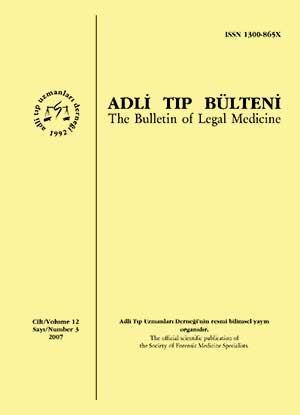Abstract
The most common burn causes of childhood are due to contact to a hot subject and scalding. The injury generally results from an incident but in 6-20% of the cases there may be neglect. Burns due to neglect are generally scalding injuries. Between 2002-2006, 82 patients whose ages were between 0-15 years old were treated in Gulhane Military Medical Academy Department of Plastic and Reconstructive Surgery and Burn Center. In this study, the patient charts of these 82 patients were retrospectively evaluated. Age, sex, etiology of burn injury, severity of burn injury, hospitalization time mortality and morbidity of the patients were evaluated. Of the patients, 72% had scalding injury, 19% had flame injury with inhalation injury, 5% had electrical injury and 4% had contact injuries. The average total body surface area of burn (TBSA) of the patients was 20.71% and the mortality rate was 17.1%. During childhood period, the detection of the neclegt of the child-sitter or the family is quite difficult. As the patient is not fully able to explain himself, the event is easily misdiagnosed as an accident. The localization and the characteristics of the burn injury will help us to differentiate accident from neglect as an etiology. When an evidence of neglection of children is determined, the judicial responsibility of the health care personnel increases. In such cases the judicial procedures must be started.
Key words: Child, burn, neglect
References
Reed JL, Pomerantz WJ. Emergency management of pediatric burns, Pediatric Emergency 2005;21:118-129.
Thompson S. Accidental or inflicted. Pediatr Ann 2005;34:373-381.
Andronicus M, Oates RK, Peat J, Spalding S, Martin H. Non-accidental burns in children Burns 1998; 24:552-558.
Weimer CL, Goldfarb IW, Slater H. Multidisciplinary approach to working with burn victims of child abuse J Burn Care Rehabil 1988;9:79-82.
Peck MD, Priolo-Kapel D. Child abuse by burning: a review of the literature and an algorithm for medical investigations J Trauma 2002;53:1013-22.
Zenel J, Goldstein B. Child abuse in the pediatric intensive care unit Crit Care Med 2002;30:(Suppl.) 515-523.
Palmieri TL. Pediatric Burn Management Problems in General Surgery 2003;20:27-36.
Çakar KS, Soran A. Ülkemizde yanık epidemiyolo- jisi: 3425 hastanın analizi T.C.D.D. Hastaneleri Tıp Bülteni 1994;2:79-84.
Günay K, Taviloğlu K, Eskioğlu E, Ertekin C. Yanıklı hastalarda epidemiyoloji ve mortalité çalışması Ulusal Travma Dergisi 1995; 1 (2):205-208.
Purdue GF, Hunt JL, Prescott PR. Child abuse by burning-an index of suspicion J Trauma 1988 28(2):221-4.
Türegün M, Şengezer M, Selmanpakoğlu N, Çeli- köz B, Nişancı M. The last 10 years in a burn centre in Ankara, Turkey: an analysis of 5264 cases. Burns 1997;23(7-8):584-90.
Showers J. Burn abuse: a four-year study The Journal of Trauma 1988;28:1581-1583.
Polat O. Çocuk ve şiddet, DER yayınları İstanbul 2001.
Ruth GD, Smith S, Bronson M, Davis AT,Wilcox RM. Outcomes related to burn-related child abuse: A Case Series Journal of Burn Care & Rehabilitation 2003;24:318-321.
The Journal and content of this website is licensed under the terms of the Creative Commons Attribution (CC BY) License. The Creative Commons Attribution License (CC BY) allows users to copy, distribute and transmit an article, adapt the article and make commercial use of the article. The CC BY license permits commercial and non-commercial re-use of an open access article, as long as the author is properly attributed.
